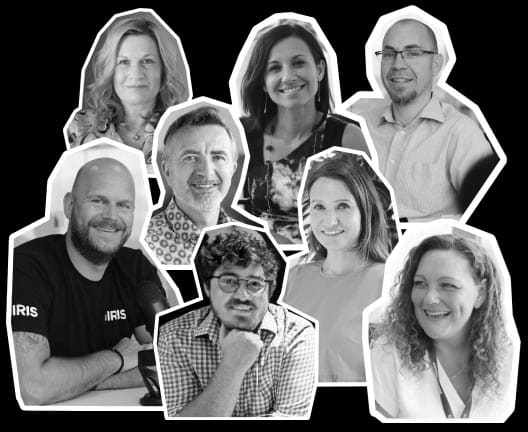HR software: Reimagining people management for the future
Updated 24th April 2025 | 7 min read Published 1st April 2025

The tools we HR professionals now have access to enable us to do so much more with our time.
Gone are the days of managing paper records and temperamental spreadsheets.
But why have the increases in productivity not been matched by feelings of wellbeing amongst the HR Community?
Research found that more than 40% of HR teams are feeling overwhelmed.
I recently had the pleasure of speaking on a webinar, in which we explored the use of technology to simplify the world of HR.
In this blog, I’ve summarised some of our discussion, detailing how I see the HR industry utilising technology to better manage people processes.
How YOU can use technology
A recent Gartner study which looks at upcoming HR trends highlighted that in 2025, a major hurdle HR leaders will need to overcome is truly capitalising on the improved business performance and value HR technology transformation can deliver.
The study found that 55% of HR leaders say current HR technology solutions do not cover their current and future needs.
This research highlights the need for HR teams to make better use of technology or seek entirely new software that can meet the needs of their business.
But how can you realistically use HR software to streamline your working day? What is the goal?
Automating the mundane
Let’s face it, we didn’t get into HR to manage spreadsheets and employee records.
Our passion stems from supporting real people and making a difference.
With this in mind, ask yourself: how much of your time is spent on administrative work?
If I could offer a single piece of advice, it would be to use technology to automate as much as possible.
Automation takes care of repetitive, time-consuming tasks so you can focus on more strategic work and better support your people.
At IRIS, one of the automation projects we’ve been working on is the communications sent to new starters.
It’s now built into the software that a new starter receives an email on their first day, fifth day and then every week after, providing them more information about our company.
For example, these emails cover topics such as getting to grips with our internal systems or learning about our holiday policy.
In a typical month, we usually have around 70 new starters and there’s no way we’d have the capacity to manually communicate this frequently – it’d be someone’s full-time job just to send our new starter emails.
We’ve used automation to support new starters because that’s a challenge our department was facing, but this same workflow can apply to numerous other scenarios.
Think about the painfully repetitive HR work you do each week.
Chances are that there’s an option to automate it with your cloud HR software.
Freeing yourself up to be more strategic
I’ve seen a real shift in HR wanting to make sure they have that seat at the senior leadership table, ensuring what we do is taken seriously and that we can demonstrate the value we deliver to the business.
However, we’re still required to handle vital day-to-day responsibilities such as making sure people are being paid correctly and managing absences – these can be a huge time drain!
As an industry, we need to back ourselves with good systems that can make these tasks manageable, otherwise, we’ll never find the time or head space to deliver that strategic vision.
Using software to guide your strategy
Automation frees up our time, but we can make our systems work even harder for us.
Using surveys to gauge employee sentiment, creating dashboards that track voluntary turnover and determining if a certain department has more churn are a few of the areas software can help.
Regularly running these activities and assessing this data is a great way of determining high-priority problem areas in the business which you can then actively work to resolve.
Once you’ve uncovered these challenges, you’re then better equipped to tackle them.
Unlocking meaningful insights
What are your business and HR goals? Do you have the necessary data? Is it up to date? Is it reliable?
A common HR metric is employee attrition – how quickly are people leaving and why?
Talent retention is a hot topic and a high number of leavers could indicate wider problems in the business which need solving.
If this was an issue you were looking to tackle, some key metrics you might want to track include:
- Are people leaving certain departments?
- Are certain roles leaving at a higher rate than others?
- Are people leaving after a particular length of service?
- Are people using the training courses on offer?
- Are people having learning & development (L&D) discussions?
- Are people having regular objectives set?
- Are people being promoted?
Answering these types of questions is crucial for informing your HR strategy.
To get good data, you need HR software to provide the necessary interface for collecting key information.
For example, having a dedicated leavers screen collects key information such as reasons for departure and can feature questionnaires.
This type of functionality can apply to a range of scenarios, from capturing information when onboarding new starters to comprehensive quarterly review processes.
HR software also enables you to create handy dashboards in the system, providing a centralised, real-time location for all the common data areas you’ll need throughout your day-to-day.
As well as the dashboards, good HR software enables you to quickly build reports within the system, which can also be scheduled to run regularly, saving you from pulling the same data set again and again.
Having this information at your fingertips gives HR a much more strategic view.
Meeting the needs of the business
I think as HR evolves and cements its strategic position, the wider business will expect more of us.
Leaders want to see this data and understand the impact.
HR needs to be on point to deliver the insight and make recommendations.
We can only deliver if we have the time and the information – something HR software can provide.
The connected workplace
In our recent webinar, I had the pleasure of speaking with Claire Dawes, Payroll Administrator at The Federation of Jewish Services, facilitating an insightful discussion on how the right technology can lighten the load, reduce frustration and help professionals reclaim their time.
If you’re feeling the strain of outdated processes and increasing demands, be sure to give it a watch!
You won’t want to miss this opportunity to explore solutions that will improve efficiency, accuracy, and wellbeing.





